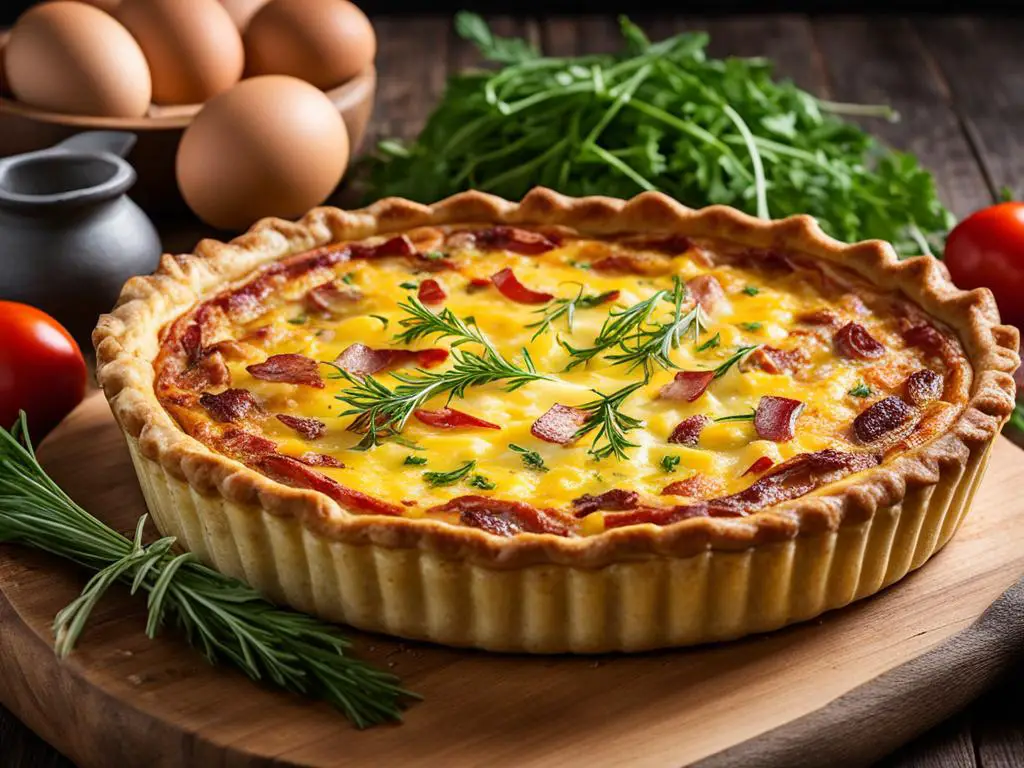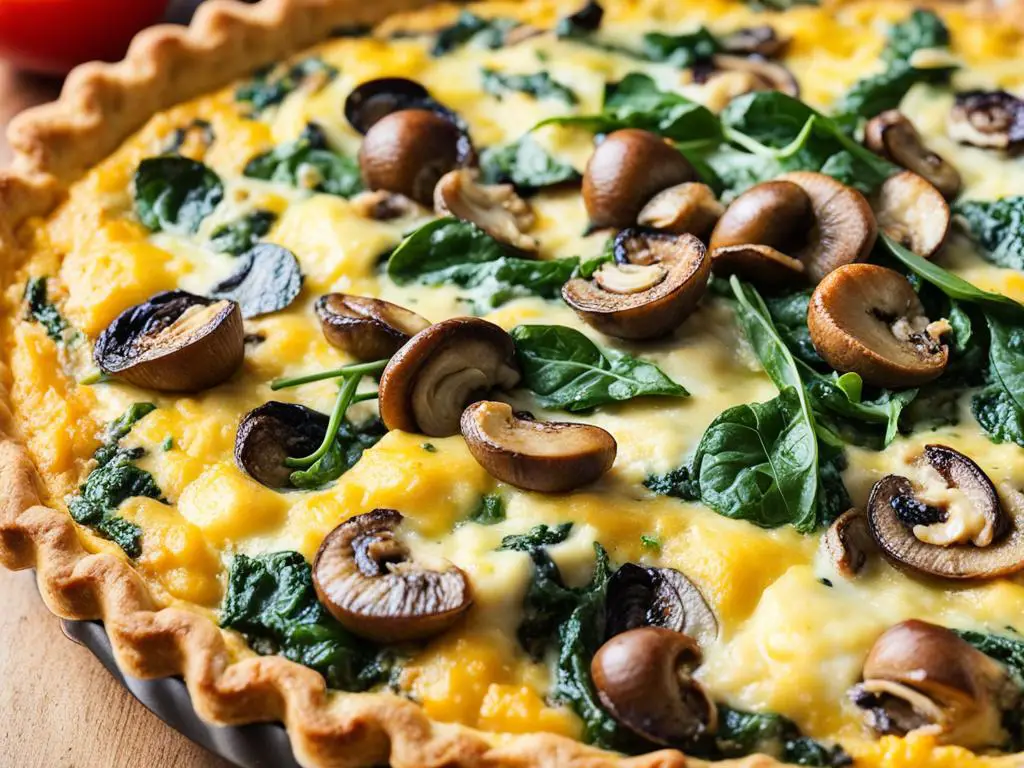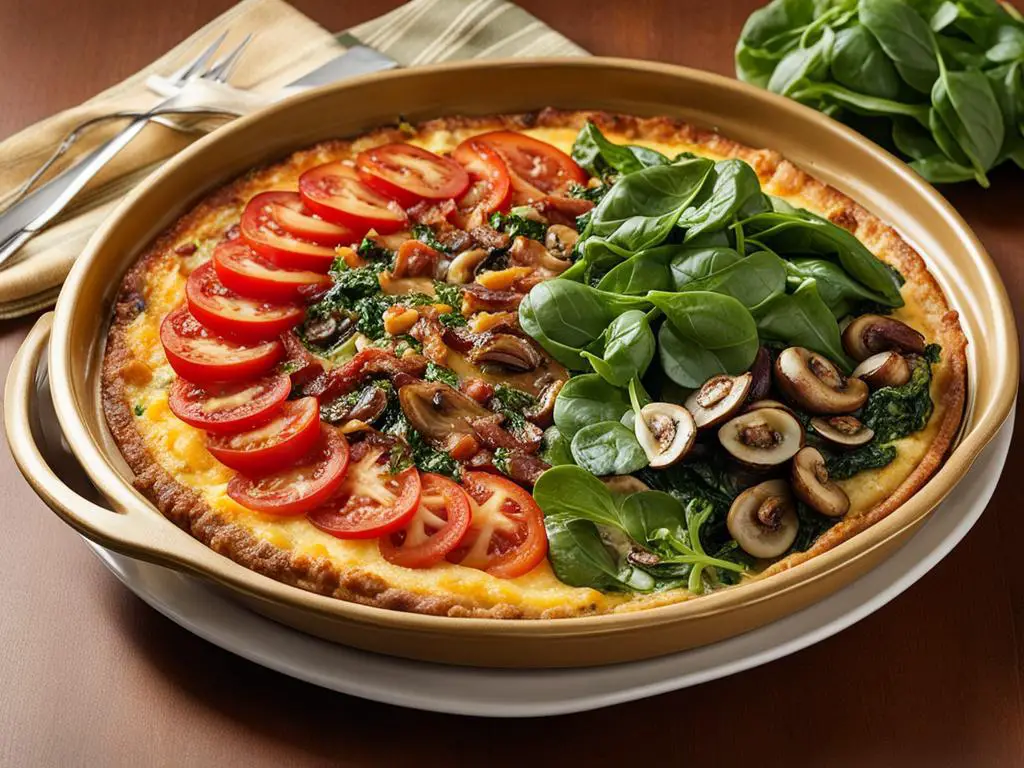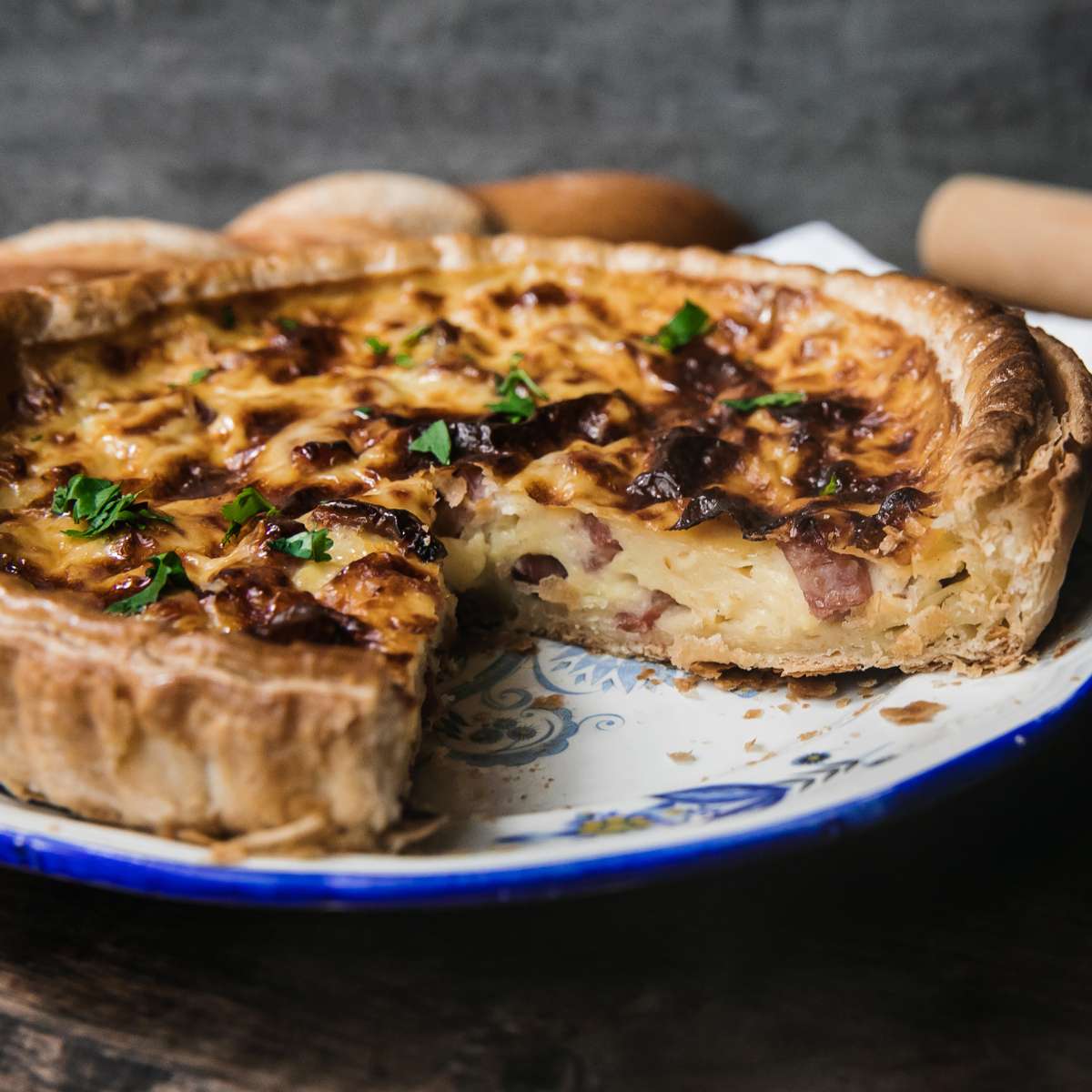What is quiche, you might ask? It’s a savory dish that has become a favorite in kitchens worldwide, known for its creamy, custard-like filling encased in a flaky pastry crust.
Originating from Europe, quiche is celebrated for its versatility and the ease with which it can be adapted to include a variety of ingredients such as eggs, cream, cheese, meats, and vegetables. It’s perfect for any meal, whether it’s a hearty breakfast, a light lunch, or a filling dinner.
In this article, we’ll explore the different types of quiche, dive into its rich history, and provide tips on how to create your own delicious versions. Keep reading to discover the many ways you can customize quiche to delight your palate and fit your dietary needs.
What is Quiche?
Quiche is a savory tart that beautifully blends the culinary traditions of Germany and France. Originally from medieval Germany, this dish was adopted by the French and became a celebrated part of their cuisine. Quiche is much more than just an “egg pie”; it’s a versatile creation that can incorporate a variety of ingredients, typically including eggs, bacon, cheese, and a rich, buttery crust.
Despite some misconceptions of quiche being an elite or upscale dish, it’s actually quite humble and hearty, made with simple, wholesome ingredients. It has shattered its highbrow stereotype to become a beloved meal that transcends social and economic boundaries.
In America, quiche has enjoyed a varied reputation, evolving from an exotic import to a staple at brunch cafés and home kitchens alike. Its ease of preparation and adaptability have made it a favorite across the country, capable of embracing a wide range of flavors and ingredients.
Quiche’s enduring appeal lies in its ability to blend tradition with versatility, making it a staple in both American and international cuisines. Whether served at a simple family dinner or as part of a sophisticated buffet, quiche remains a timeless dish that unites people through a shared love of comforting, delicious food.
Related Article: While exploring what is quiche, you may also be interested in other French culinary delights. Check out our articles on “What is Crepe?” for a dive into France’s beloved thin pancakes and “Clafoutis: French Baked Cherry Tart” for a sweet take on a classic dessert.
What is Quiche: Exploring the Core Ingredients
Quiche, the classic savory custard pie, boasts a delightful blend of ingredients that have made it a favorite in households everywhere. The main components of this versatile dish include pie crust, eggs, cheese, bacon, and whipping cream. Let’s dive into the details and discover what makes a quiche truly delectable.
Every quiche starts with a solid foundation – the pie crust. Store-bought or homemade, the crust provides a vessel for the rich, creamy filling concocted from the other core ingredients. Next come the eggs, the backbone of the dish. Beaten and mixed with whipping cream and milk, the eggs create the quintessential custard consistency that defines the quiche.
To add depth and flavor to the dish, generous portions of cheese and bacon are integral. Swiss cheese is the traditional choice, offering a subtle nutty flavor that complements the smokiness of the crumbled bacon. Finally, seasonings such as salt, pepper, powdered mustard, and cayenne pepper elevate the flavors and bring every bite to life.
And of course, no quiche would be complete without a touch of culinary creativity. Optional ingredients like shredded carrots, diced onions, or bell peppers can further enhance the dish, truly showcasing the accommodating nature of quiche and its remarkable ability to suit an array of tastes and preferences.
What is Quiche Lorraine: A Classic Dish that Took America by Storm
In the 1950s, Quiche Lorraine emerged as the quintessential variant that captured America’s hearts and stomachs, earning it a staple position in 1950s American cuisine. Known for its rich blend of eggs, heavy cream, cheese, and bacon, this classic dish exemplifies the culinary evolution of quiche in the United States.

Originally, Quiche Lorraine featured more heavy cream than eggs, aligning with traditional French cuisine. Over time, as American preferences evolved, the recipe adapted, incorporating more eggs and introducing vegetables like asparagus, broccoli, and spinach. This shift not only reflects changing dietary trends but also highlights quiche’s adaptability to different tastes and ingredients.
Quiche Lorraine Versus Modern American Quiches
The table below highlights key differences between the classic Quiche Lorraine and some popular modern American quiches:
| Type of Quiche | Key Ingredients | Distinct Features |
|---|---|---|
| Quiche Lorraine | Eggs, heavy cream, cheese, bacon | Historic classic, emphasis on the interplay between cream, cheese, and bacon |
| American Quiche with Broccoli and Cheddar | Eggs, cream, broccoli, cheddar cheese | Popular combination of vegetables and cheese, kid-friendly option |
| Crustless Spinach and Feta Quiche | Eggs, milk, spinach, feta cheese | A popular combination of vegetables and cheese, a kid-friendly option |
Whether you prefer the classic taste of Quiche Lorraine or the endless creative variations possible with contemporary American quiches, there’s no doubt that these delightful, egg-based recipes will continue to captivate home cooks and food enthusiasts alike.
How to Make Quiche at Home
Making a delicious quiche from scratch is an easy and rewarding process. From the basic shopping list to mastering preparation techniques, quiche can be a scrumptious addition to your culinary repertoire. Let’s dive into the essentials of quiche-making.

Your Basic Quiche Shopping List
To get started with your quiche, you’ll need the following ingredients:
- Pie crust (pre-made or homemade)
- Swiss cheese
- Bacon or ham
- Eggs
- Whipping cream
- Milk
- Spices (salt, pepper, powdered mustard, cayenne pepper)
Optional ingredients such as shredded carrots, diced onions, or bell peppers can further set your quiche apart and cater to your personal taste preferences.
Preparation Techniques for the Perfect Quiche
Before beginning the baking process, it’s essential to follow a few key kitchen tips and cooking techniques:
- Preheat your oven to 425°F (218°C) before baking the quiche to ensure it cooks evenly from the start.
- Separate wet and dry ingredients, combining them in a large bowl after browning the bacon and chopping the cheese into small pieces.
- After pouring the mixture into the pie crust, bake the quiche at high heat for 15 minutes at 425°F
- Lower the oven temperature to 350°F (177°C) and continue baking for an additional 30-40 minutes, using a toothpick or butter knife to test for doneness.
Customizing Your Quiche: A Guide to Personalized Varieties

Quiche offers a fantastic canvas for culinary creativity, allowing you to tailor the dish to your personal taste or dietary needs. Here’s how you can customize your quiche, making each version unique and delicious:
- Meat Variations:
- Chicken, mushrooms, and feta cheese for a rich and earthy flavor.
- Chorizo, bell peppers, and pepper jack cheese for a spicy kick.
- Vegetarian Delights:
- Artichokes, sun-dried tomatoes, and goat cheese for a Mediterranean touch.
- Gluten-Free Options:
- Try a hashbrown crust for a crunchy, gluten-free base.
- Almond flour or another gluten-free grain can also make an excellent crust alternative.
- Nutrient-Dense Ingredients:
- Roasted vegetables like zucchini, Brussels sprouts, or cherry tomatoes add color and nutrients.
- Incorporate power greens such as spinach, kale, or Swiss chard for added vitamins.
- Include lean meats like turkey or chicken sausage for protein without the fat.
- Add heart-healthy fats from avocados or nuts for richness and texture.
By exploring these various combinations and experimenting with ingredients, you can transform a traditional quiche into a custom culinary creation that reflects your preferences and dietary requirements. Whether you’re aiming for a heartier meal or a light, nutritious option, the versatility of quiche makes it easy to adapt and enjoy in countless ways.
Quiche’s Close Cousins: Frittata and Strata
While quiche is known for its creamy texture and milk or cream base, there are similar breakfast dishes that also hold their own in the easy egg recipe department. Enter frittata and strata, quiche’s close cousins, each offering a unique take on savory egg recipes.
Quiche vs. Frittata
The Italian frittata is quite similar to an omelet. It’s made by thoroughly beating eggs with a touch of milk or cream and then cooking the mixture, often finishing it in the oven.
Unlike quiche, frittatas do not have a pastry crust, which makes them a popular choice for those on gluten-free or low-carb diets. Ingredients like vegetables, cheeses, and meats are mixed directly into the eggs, creating a hearty and flavorful dish.
Quiche vs. Strata
Strata, on the other hand, has its roots in American cuisine and presents a unique twist to a savory bread pudding. It involves layering slices or cubes of bread with fillings such as meats, vegetables, and cheeses. The layers are then soaked in a mixture of eggs and milk or cream and baked until golden. This results in a delicious, layered dish that’s perfect for breakfast or brunch.
The term “strata” itself comes from the Latin word “stratum,” meaning a layered structure, which perfectly describes the dish’s composition.
Choosing Between These Eggy Delights
When it comes to deciding which of these dishes to prepare, it might come down to dietary restrictions, personal taste, or the ingredients you have on hand. Still, all three options contribute to the rich tapestry of egg-based recipes suitable for various occasions. A glance at some of the differences can help you make your choice:
| Quiche | Frittata | Strata |
|---|---|---|
| Has a pie crust | No pie crust | Layered with bread |
| Uses a milk or cream base | Uses a small amount of milk or cream | Soaked in an egg and milk or cream mixture |
| Baked in the oven | Usually starts on the stovetop and finishes in the oven | Baked in the oven |
Incorporating Quiche into a Balanced Diet
Quiche is not only a delicious and versatile dish but also a valuable addition to a balanced diet, largely due to its primary ingredient: eggs. Once thought to contribute to high cholesterol, eggs have now been recognized by nutrition experts for their health benefits.
Nutritional Benefits of Quiche
- Rich in High-Quality Protein: Eggs are a complete source of protein, making quiche a fantastic meal option that supports muscle repair and growth.
- Versatile and Nutrient-Dense: Adding a variety of vegetables to your quiche can increase its fiber and vitamin content, enhancing its nutritional profile.
- Customizable for Healthier Options: Incorporating lean meats like turkey or chicken instead of higher-fat meats can make your quiche a leaner, healthier option. Choosing whole-grain or gluten-free crusts can also cater to specific dietary needs, making quiche adaptable to various health requirements.
Ways to Enhance Quiche for Your Diet
- Opt for Healthy Proteins: Use lean proteins such as chicken or turkey to keep the fat content low while maintaining the flavor.
- Choose Your Crust Wisely: For those with dietary restrictions, a whole-grain or gluten-free crust can make quiche a feasible option without sacrificing taste.
- Add Color with Vegetables: Mix in spinach, tomatoes, or bell peppers to boost the antioxidant content and make your quiche more vibrant and nutritious.

Overall, quiche effortlessly fits into your balanced diet while maintaining its appetizing charm. Whether as a protein-rich breakfast, a nutritious lunch, or a wholesome dinner, quiche’s adaptability and health benefits make it an appealing choice for any meal.
Conclusion
As we have explored, quiche offers a delightful culinary adventure that combines tradition, innovation, and versatility. With its rich custard filling and tender pastry crust, it can be customized with a variety of ingredients to suit any palate or dietary need.
Whether you’re enjoying a simple Quiche Lorraine or experimenting with your own combinations of flavors, quiche is sure to provide a satisfying and nutritious meal. As you explore the world of quiche, you’ll discover just how adaptable and enjoyable this classic dish can be.
FAQ
Is quiche served hot or cold?
Quiche can be enjoyed both hot and cold, making it a versatile dish for leftovers or planned meals.
What is the difference between Quiche Lorraine and a modern American quiche?
Quiche Lorraine is the classic version that popularized quiche in America, featuring a specific ratio of eggs, heavy cream, cheese, and bacon. Modern American quiches often use more eggs and a variety of additional ingredients, such as asparagus, spinach, and other vegetables.
Can I make a quiche without a crust?
Yes, a crustless quiche is often referred to as a quiche custard and is a great option for those following a gluten-free or lower-carb diet.
How long does quiche last in the refrigerator?
Cooked quiche can be stored in the refrigerator for up to 3-4 days. Make sure it’s covered properly or stored in an airtight container.
How can I make my quiche healthier?
Opt for low-fat dairy options, increase the ratio of vegetables to meat, and use lean meats like turkey or chicken. You can also try a whole-grain or gluten-free crust.
Why is quiche so popular for brunch?
Quiche is a popular brunch menu option because of its versatility, savory breakfast flavors, and compatibility with various ingredients, making it an ideal dish to cater to a wide range of taste preferences.



